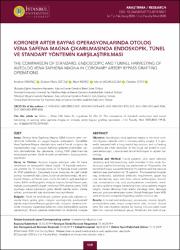| dc.contributor.author | Erdinç, İbrahim | |
| dc.contributor.author | Öztas, Didem Melis | |
| dc.contributor.author | Meriç, Mert | |
| dc.contributor.author | Uğurlucan, Murat | |
| dc.contributor.author | Oto, Öztekin | |
| dc.date.accessioned | 2020-04-13T13:29:53Z | |
| dc.date.available | 2020-04-13T13:29:53Z | |
| dc.date.issued | 2020 | en_US |
| dc.identifier.citation | Erdinç, İ., Öztas, D. M., Meriç, M., Uğurlucan, M. ve Oto, Ö. (2020). Koroner arter baypas operasyonlarında otolog vena safena magna çıkarılmasında endoskopik, tünel ve standart yöntemin karşılaştırılması. İstanbul Tıp Fakültesi Dergisi, 83(2), 119-126. https://dx.doi.org/10.26650/IUITFD.2019.0021 | en_US |
| dc.identifier.issn | 1305-6441 | |
| dc.identifier.uri | https://hdl.handle.net/20.500.12511/5109 | |
| dc.identifier.uri | https://dx.doi.org/10.26650/IUITFD.2019.0021 | |
| dc.description.abstract | Amaç: Otolog Vena Saphena Magna (VSM) koroner arter cerrahisinde kullanılan en yaygın baypas materyalidir. Genellikle Vena Saphena Magna standart uzun medial bacak insizyonu ile hazırlanmakta olup; insizyon hattında iyileşme problemleri sıklıkla izlenmektedir. Bu çalışmada, otolog VSM çıkarılmasında endoskopik yöntem, klasik ve tünel yöntemlerinin karşılaştırması yapılmıştır.Gereç ve Yöntem: Koroner baypas ameliyatı olan 40 hastarandomize ve retrospektif olarak seçildi. 10 hastada endoskopik yöntem ile, 15 hastada tünel ve 15 hastada klasik yöntemile VSM çıkarılmıştır. Çalışmada bacak insizyonu ile ilgili olarakpostop hastanede kalış süresi, kullanılan antibiyoterapi, ek antibiyotik ihtiyacı, üst bacak çapı, sızıntı, hematom, açık yara bakım süresi, kültür antibiyogram, insizyon boyutu, komplikasyon yeri,maliyet, postoperatif şikayet, ortalama VSM çıkarma süresi, VSM uzunluğu, kapalı pansuman günü, elastik bandaj süresi, drenajmiktarı, postoperatif ağrı skorlaması karşılaştırılmıştır.Bulgular: Tünel ve endoskopik yöntem grubunda çalışma sonunda klasik gruba göre, insizyon uzunluğunda, postoperatif ağrıda, major komplikasyon gelişiminde, insizyonu kapama süresinde, insizyonu kapamada kullanılan sütür materyalinde azalma saptanmıştır. Bunun yanında mükemmel bir kozmetik sonuçla hasta memnuniyeti artmış, erken dönemde mobilizasyonda rahatlık sağlanmıştır.Sonuç: Klasik yönteme göre endoskopik teknik ve tünel yöntemiuygulanan hastalarda bacaktaki insizyon sorunlarının daha az görüldüğü ve hastanede kalış süresinin, kullanılan sütür materyalimiktarı ve insizyonu kapama süresinin, insizyon uzunluğunun vepostoperatif ağrının daha az olduğu gözlenmiştir. Hastanın mobilize olma süresinin de kısaldığı saptanmıştır. Bu sonuçlara göreendoskopik ve tünel yöntemlerinin kullanımının klasik yöntemeüstünlüğü göz önünde bulundurulmalıdır. | en_US |
| dc.description.abstract | Objective: Autologous vena saphena magna is the most common bypass material used in coronary artery surgery. It is generally prepared with a long medial leg incision, and so healing problems are often observed. In this study, we aimed to compare endoscopic, classical and tunnel techniques in saphen harvesting.Material and Method: Fourty patients, who were selected randomly and retrospectively, were included in the study. Endoscopic saphen harvesting was performed on 10 patients, the tunnel technique was performed on 15 patients and the classical method was performed on 15 patients. Postoperative hospital stay, antibiotics, additional antibiotic requirement, upper leg size, hematoma, open care time, culture antibiogram, incision size, complication site, cost, postoperative complaints, median vena saphena magna harvesting time, vena saphena magna length, closed dressing time, elastic bandage time, drenaige amount, postoperative pain scores (Visual Analogue Scale-VAS) were all factors compared regarding saphen insicion site.Results: In tunnel end endoscopic procedures; insicion length, postoperative pain, major complication rate, incision closure time, the sutur material reqired for closing incisions were lower than the classical technique group. Moreover, the level of patients' satisfaction was increased due to perfect cosmetic results and ease of early mobilization.Conclusion: Comparing classical saphen harvesting techniques with endoscopic and tunnel methods, it was found that incision problems, length of hospital stay, sutur material amounts, incision closure time, incision length and postoperative pain were detected in lower numbers in endoscopic and tunnel methods. Depending on these factors, the patient's mobilization time was shortened. According to these results, the superiority of the endoscopic and tunnel methods compared to the classical method should be considered. | en_US |
| dc.language.iso | tur | en_US |
| dc.publisher | İstanbul Üniversitesi Yayınevi | en_US |
| dc.rights | info:eu-repo/semantics/openAccess | en_US |
| dc.subject | Koroner Baypas | en_US |
| dc.subject | Vena Safena Magna | en_US |
| dc.subject | Minimal İnvaziv Teknikler | en_US |
| dc.subject | Coronary Bypass | en_US |
| dc.subject | Vena Saphena Magna | en_US |
| dc.subject | Minimally İnvasive Techniques | en_US |
| dc.title | Koroner arter baypas operasyonlarında otolog vena safena magna çıkarılmasında endoskopik, tünel ve standart yöntemin karşılaştırılması | en_US |
| dc.title.alternative | The comparison of standard, endoscopic and tunnel harvesting of autolog vena saphena magna in coronary artery bypass grafting operations | en_US |
| dc.type | article | en_US |
| dc.relation.ispartof | İstanbul Tıp Fakültesi Dergisi | en_US |
| dc.department | İstanbul Medipol Üniversitesi, Tıp Fakültesi, Cerrahi Tıp Bilimleri Bölümü, Kalp ve Damar Cerrahisi Ana Bilim Dalı | en_US |
| dc.authorid | 0000-0001-6643-9364 | en_US |
| dc.identifier.volume | 83 | en_US |
| dc.identifier.issue | 2 | en_US |
| dc.identifier.startpage | 119 | en_US |
| dc.identifier.endpage | 126 | en_US |
| dc.relation.publicationcategory | Makale - Uluslararası Hakemli Dergi - Kurum Öğretim Elemanı | en_US |
| dc.identifier.doi | 10.26650/IUITFD.2019.0021 | en_US |


















